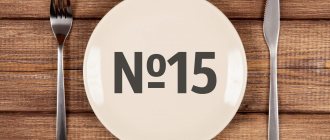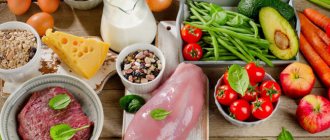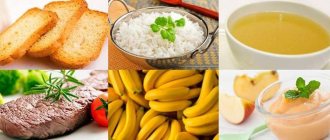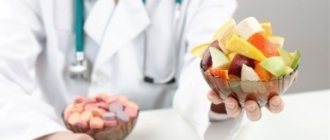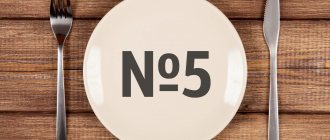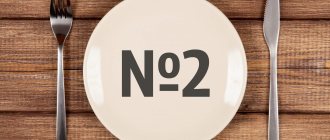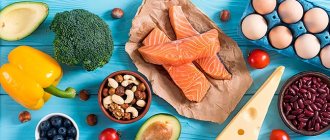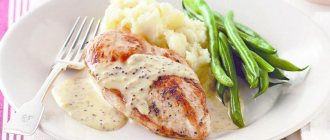11/27/2019 Article
- general characteristics
- Table "Do's and Don'ts"
- Menu for the week
- Diet modifications Diet “Table 10A”
- Diet "Table 10I"
- Diet "Table 10C"
Nutrition affects not only the state of the gastrointestinal tract, but also the state of the cardiovascular system . If the functioning of the heart and blood vessels is disrupted, the medical diet “table 10” , compiled by M. I. Pevzner, is prescribed.
The diet is indicated for:
- heart defects,
- cardiosclerosis,
- hypertension with mildly expressed signs of circulatory failure.
Only a cardiologist can prescribe a diet.
Find a trusted dietitian in your city and make an appointment online
Consultation with a nutritionist
General rules
For cardiac diseases, the tenth table and its varieties are recommended. This diet is widely used and used for heart defects , hypertension , cardiosclerosis without pronounced signs of circulatory failure (that is, in the stage of compensation and subcompensation).
What is Diet Number 10, what is its purpose and what are the basic principles of nutrition? Its purpose is to create favorable conditions for blood circulation while fully providing the body with nutrients and energy. This therapeutic food is a complete diet, but with limited salt and liquid.
Therapeutic Diet No. 10 (Table No. 10) according to Pevzner has the following features:
- contains 90 g of proteins (half animal), 80 g fat (one third vegetable) and 350-400 g carbohydrates;
- complete vitamin composition;
- dishes are prepared without salt, salt is allowed in the amount of 5 g in ready-made dishes;
- fluid consumption up to 1.5 liters.
- Regular meals are recommended (4-5 times a day);
- sugar (up to 50 g per day), partially replaced with honey, jam or preserves;
- butter up to 20 g per day and up to 30 g of vegetable oil;
- if you are overweight, limit sugar, flour and cereal products;
- spicy snacks, pickles and seasonings, fatty fried foods, fatty meats and fish, broths are excluded;
- Drinks that stimulate the central nervous system (alcohol, strong tea and coffee) are limited.
These are the basic principles, but the diet has many variations that are adapted to different diseases of the cardiovascular system. For example, nutrition for atherosclerosis consists of reducing the consumption of animal fats, eliminating the intake of cholesterol and easily digestible carbohydrates from food. At the same time, it is planned to increase the consumption of dietary fiber. It is important to increase the proportion of plant and fish proteins in relation to animal proteins.
The diet for hypertension has its own characteristics: limiting salt intake (food is prepared without salt, then food can be added with salt, consuming 5-6 g per day), eliminating substances that excite the central nervous system. Losing weight and maintaining potassium and magnesium levels in the blood are important. For this purpose, rice, millet, raisins, milk, oatmeal, cabbage, prunes, dried apricots, rosehip decoction, beets, bran bread, carrots, potatoes, nuts, perch, and beef are introduced into the diet. With concomitant obesity, additional fasting days are prescribed.
In case of chronic heart failure, salt intake is further limited (2-4 g), and in case of severe edema , its complete exclusion is indicated. Liquid consumption is also limited, and foods that have a diuretic effect are introduced - these are potassium-containing foods (dried apricots, raisins, grapes, apricots, dates, prunes, potatoes, cabbage, figs, rose hips, parsley). Complex and step-by-step diet therapy is prescribed for myocardial infarction .
Nutritionist's recommendations
- The main diet should consist of high-density lipoproteins with a sufficient amount of digestible vitamins.
- Food is cooked mainly by steaming without the use of fat. Vegetable oil is used for dressing salads and other dishes.
- When cooking broth from lean meat, the cooled fat is skimmed off the surface.
- Fried foods, as well as canned foods and pickles, including home-made and factory-made canned meat and fish, are completely excluded.
- Smoked products are prohibited.
- There is no need to add salt during the cooking process. Table salt is used in small quantities when serving the dish.
- For home baking, use chicken protein, not yolk.
- The daily diet is five meals a day. This technique allows you to avoid overeating and minimize the feeling of hunger between meals.
Find out the causes of excess weight and ways to quickly lose weight
Sign up for a free initial appointment with a nutritionist!
The daily menu of a patient with atherosclerosis consists mainly of protein foods:
- lean meat;
- low-fat cottage cheese;
- fish.
Important! The volume of each of the above products is about 150 grams (daily).
What do protein-rich foods do?
With their help, you can create a long-lasting feeling of fullness. The human body takes longer to process such products. Therefore, repeated meals after a short period of time are not required.
Plant sterols in the diet of patients with atherosclerosis
Sterols are components that are contained in:
- in natural vegetable oils;
- in nuts;
- in legumes;
- in cereals.
Thanks to sterols, excess cholesterol is not absorbed into the bloodstream. Thus, foods high in sterols become part of a comprehensive program for the management of patients with vascular atherosclerosis. The daily norm of sterols is about two grams.
Varieties
- Diet 10A is prescribed for cardiac diseases with circulatory failure of stages II and III (decompensation stage). In this case, it is necessary to relieve the cardiovascular system as much as possible. Therefore, the amount of salt in the diet is further reduced, the calorie content is reduced (the amount of bread is reduced), there are no first courses and the amount of proteins (70 g), fats (70 g) and carbohydrates (300 g) is reduced. Increased intake of potassium and calcium.
- Diet 10B is indicated for rheumatism with low activity, without circulatory problems. The diet has increased protein content (120 g), reduced salt consumption (4 g) and a complete content of vitamins . Dishes are not salted and are served boiled or baked.
- Table 10C is recommended for atherosclerosis , coronary heart disease and atherosclerotic cardiosclerosis . This hypocholesterol or anti-sclerotic diet is aimed at slowing the progression of atherosclerosis, normalizing lipid metabolism and improving overall metabolism . Contains a normal amount of proteins, limited fat (mainly of animal origin), carbohydrates (due to simple ones) and table salt (4 g). Enriched with polyunsaturated fatty acids (vegetable oils) and dietary fiber. There are two options for this table: for non-obese people with a calorie content of 2600-2700 kcal and for those with concomitant obesity (the amount of fat is reduced to 70 g, carbohydrates to 300 g and calorie content to 2200 kcal).
- Table 10P is indicated for patients with rheumatoid arthritis . This is a complete diet, with a slight restriction of fat (70 g) and a reduction in the carbohydrate part (250 g) due to sugar and sweets. Salt is allowed in the amount of 2-3 g per day. Table 10G is recommended for arterial hypertension . Its peculiarity is the exclusion of salt or its presence in a minimal amount (up to 2 g). The daily diet contains increased levels of vitamins, potassium and magnesium salts. Seafood and vegetables included.
- Table 10I is prescribed for patients who have suffered a myocardial infarction and nutrition is aimed at accelerating reparative processes in the heart muscle and improving circulatory function. It has a reduced calorie content, salt and dishes that cause flatulence . Food is served in a semi-liquid state, since the patient is on bed rest. In the first 2 days, only drinks are prescribed (a decoction of dried fruits, weak, slightly sweetened tea). From the third, pureed food in small portions is allowed. Then the diet gradually expands.
Chemical composition and energy value of dietary table No. 10
Proteins: 85–90 g (including 45 g animal proteins). Fats: 70–80 g (including at least 30 g of vegetable fats). Carbohydrates: 300–350 g. Daily calorie content: 2,200–2,400 kcal. Free liquid: 1.5–2 l. Table salt: 6–8 g Vitamins: retinol (A) – 0.3 mg, riboflavin (B2) – 2.5 mg, thiamine (B1) – 1.7 mg, nicotinic acid (B3) – 22 mg, ascorbic acid acid (C) – 150 mg. Macroelements: sodium – 2.6 g, potassium – 4.2 g, calcium – 1 g, phosphorus – 1.8 g. Microelements: iron – 6 mg. Optimal food temperature: from 15 to 65 degrees Celsius.
Authorized Products
Bread may be made from wheat or rye, as well as from peeled flour, whole grain and with bran. You can eat dry cookies, homemade savory baked goods with added bran. The filling can be cottage cheese, cabbage, fish or meat.
Vegetable soup with cereals
Vegetable soups and vegetarian soups with cereals are allowed. They are boiled in water or vegetable broth. Low-fat varieties of meat and poultry are recommended, boiled and baked. To reduce extractive substances, meat must first be boiled and then baked or lightly fried. The diet should consist of fish and seafood dishes.
The side dish is prepared from cabbage, carrots, zucchini, beets, eggplants, pumpkin and potatoes in the form of a vegetable stew. Salads with seasonal vegetables are consumed fresh. For appetizers, vinaigrettes seasoned with vegetable oil, seaweed, and soaked herring are allowed.
Milk and fermented milk products are recommended with reduced fat content, low-fat sour cream (only in dishes) and low-fat cottage cheese. Eggs are allowed up to 4 per week and are cooked soft-boiled. Porridges and casseroles with cottage cheese and vegetables are prepared from pasta and cereals such as barley, buckwheat, millet and oatmeal. With increased weight, cereals and flour products are strictly limited. Butter and vegetable oils are used in dishes and for cooking.
Fruits and berries can be consumed raw, as well as in compotes and jellies. If there is a need to prepare sauces, then they need to be prepared with vegetable broth or milk and tomato sauces with sour cream. You can drink weak tea with milk, coffee substitutes (coffee drinks), vegetable and berry juices. A daily intake of rosehip decoction is recommended.
Table of permitted products
| Proteins, g | Fats, g | Carbohydrates, g | Calories, kcal | |
Vegetables and greens | ||||
| greenery | 2,6 | 0,4 | 5,2 | 36 |
| eggplant | 1,2 | 0,1 | 4,5 | 24 |
| zucchini | 0,6 | 0,3 | 4,6 | 24 |
| cabbage | 1,8 | 0,1 | 4,7 | 27 |
| broccoli | 3,0 | 0,4 | 5,2 | 28 |
| boiled cauliflower | 1,8 | 0,3 | 4,0 | 29 |
| bulb onions | 1,4 | 0,0 | 10,4 | 41 |
| carrot | 1,3 | 0,1 | 6,9 | 32 |
| cucumbers | 0,8 | 0,1 | 2,8 | 15 |
| salad pepper | 1,3 | 0,0 | 5,3 | 27 |
| salad | 1,2 | 0,3 | 1,3 | 12 |
| beet | 1,5 | 0,1 | 8,8 | 40 |
| celery | 0,9 | 0,1 | 2,1 | 12 |
| asparagus | 1,9 | 0,1 | 3,1 | 20 |
| tomatoes | 0,6 | 0,2 | 4,2 | 20 |
| Jerusalem artichoke | 2,1 | 0,1 | 12,8 | 61 |
| pumpkin | 1,3 | 0,3 | 7,7 | 28 |
| lentils | 24,0 | 1,5 | 42,7 | 284 |
Fruits | ||||
| avocado | 2,0 | 20,0 | 7,4 | 208 |
| oranges | 0,9 | 0,2 | 8,1 | 36 |
| pomegranate | 0,9 | 0,0 | 13,9 | 52 |
| grapefruit | 0,7 | 0,2 | 6,5 | 29 |
| pears | 0,4 | 0,3 | 10,9 | 42 |
| kiwi | 1,0 | 0,6 | 10,3 | 48 |
| lemons | 0,9 | 0,1 | 3,0 | 16 |
| mango | 0,5 | 0,3 | 11,5 | 67 |
| tangerines | 0,8 | 0,2 | 7,5 | 33 |
| nectarine | 0,9 | 0,2 | 11,8 | 48 |
| peaches | 0,9 | 0,1 | 11,3 | 46 |
| apples | 0,4 | 0,4 | 9,8 | 47 |
Berries | ||||
| gooseberry | 0,7 | 0,2 | 12,0 | 43 |
| Red currants | 0,6 | 0,2 | 7,7 | 43 |
| black currant | 1,0 | 0,4 | 7,3 | 44 |
Nuts and dried fruits | ||||
| nuts | 15,0 | 40,0 | 20,0 | 500 |
| cashew | 25,7 | 54,1 | 13,2 | 643 |
| sesame | 19,4 | 48,7 | 12,2 | 565 |
| flax seeds | 18,3 | 42,2 | 28,9 | 534 |
| fenugreek seeds | 23,0 | 6,4 | 58,3 | 323 |
| sunflower seeds | 20,7 | 52,9 | 3,4 | 578 |
Cereals and porridges | ||||
| buckwheat (kernel) | 12,6 | 3,3 | 62,1 | 313 |
| oat groats | 12,3 | 6,1 | 59,5 | 342 |
| cereals | 11,9 | 7,2 | 69,3 | 366 |
| millet cereal | 11,5 | 3,3 | 69,3 | 348 |
| barley grits | 10,4 | 1,3 | 66,3 | 324 |
Bakery products | ||||
| Rye bread | 6,6 | 1,2 | 34,2 | 165 |
Confectionery | ||||
| Maria cookies | 8,7 | 8,8 | 70,9 | 400 |
Raw materials and seasonings | ||||
| honey | 0,8 | 0,0 | 81,5 | 329 |
Dairy | ||||
| skim milk | 2,0 | 0,1 | 4,8 | 31 |
| natural yogurt 2% | 4,3 | 2,0 | 6,2 | 60 |
Cheeses and cottage cheese | ||||
| cottage cheese 0.6% (low fat) | 18,0 | 0,6 | 1,8 | 88 |
| curd tofu | 8,1 | 4,2 | 0,6 | 73 |
Meat products | ||||
| beef | 18,9 | 19,4 | 0,0 | 187 |
| rabbit | 21,0 | 8,0 | 0,0 | 156 |
Sausages | ||||
| boiled diet sausage | 12,1 | 13,5 | 0,0 | 170 |
Bird | ||||
| chicken fillet | 23,1 | 1,2 | 0,0 | 110 |
| turkey | 19,2 | 0,7 | 0,0 | 84 |
Fish and seafood | ||||
| fish | 18,5 | 4,9 | 0,0 | 136 |
| squid | 21,2 | 2,8 | 2,0 | 122 |
| mussels | 9,1 | 1,5 | 0,0 | 50 |
| seaweed | 0,8 | 5,1 | 0,0 | 49 |
Oils and fats | ||||
| butter | 0,5 | 82,5 | 0,8 | 748 |
| linseed oil | 0,0 | 99,8 | 0,0 | 898 |
| olive oil | 0,0 | 99,8 | 0,0 | 898 |
| sunflower oil | 0,0 | 99,9 | 0,0 | 899 |
Non-alcoholic drinks | ||||
| mineral water | 0,0 | 0,0 | 0,0 | — |
| green tea | 0,0 | 0,0 | 0,0 | — |
| * data is per 100 g of product | ||||
Fully or partially limited products
Fresh bread, puff and pastry dough, and broths are completely excluded. You cannot prepare soups from legumes, eat fatty pork, duck, goose, cooking fats, kidneys, liver, sausages, canned food and all kinds of smoked meats.
Fatty fish, canned fish and caviar, salted and smoked fish are prohibited. Do not eat fatty cheese and cream, cottage cheese and sour cream. The consumption of radishes, radishes, sorrel, spinach and mushrooms is prohibited. You cannot eat chocolate, ice cream, products with cream, or salty cheeses. Meat, fish, mushroom sauces, mustard, and horseradish are excluded. Strong tea and coffee, cocoa are prohibited.
Dishes made from legumes are limited, as they cause bloating and grape juice for the same reason. If obese , consume grapes, sugar, honey, raisins, and jam in minimal quantities and very rarely.
Table of prohibited products
| Proteins, g | Fats, g | Carbohydrates, g | Calories, kcal | |
Vegetables and greens | ||||
| vegetables legumes | 9,1 | 1,6 | 27,0 | 168 |
| canned vegetables | 1,5 | 0,2 | 5,5 | 30 |
| sauerkraut | 1,8 | 0,1 | 4,4 | 19 |
| pickles | 0,8 | 0,1 | 1,7 | 11 |
| radish | 1,2 | 0,1 | 3,4 | 19 |
| white radish | 1,4 | 0,0 | 4,1 | 21 |
| red radish | 1,2 | 0,1 | 3,4 | 20 |
| black radish | 1,9 | 0,2 | 6,7 | 35 |
| spinach | 2,9 | 0,3 | 2,0 | 22 |
| sorrel | 1,5 | 0,3 | 2,9 | 19 |
Fruits | ||||
| bananas | 1,5 | 0,2 | 21,8 | 95 |
Berries | ||||
| grape | 0,6 | 0,2 | 16,8 | 65 |
Mushrooms | ||||
| mushrooms | 3,5 | 2,0 | 2,5 | 30 |
Nuts and dried fruits | ||||
| raisin | 2,9 | 0,6 | 66,0 | 264 |
Confectionery | ||||
| candies | 4,3 | 19,8 | 67,5 | 453 |
| pastry cream | 0,2 | 26,0 | 16,5 | 300 |
| shortbread dough | 6,5 | 21,6 | 49,9 | 403 |
Ice cream | ||||
| ice cream | 3,7 | 6,9 | 22,1 | 189 |
Cakes | ||||
| cake | 4,4 | 23,4 | 45,2 | 407 |
Chocolate | ||||
| chocolate | 5,4 | 35,3 | 56,5 | 544 |
Raw materials and seasonings | ||||
| mustard | 5,7 | 6,4 | 22,0 | 162 |
| mayonnaise | 2,4 | 67,0 | 3,9 | 627 |
Dairy | ||||
| milk 3.6% | 2,8 | 3,6 | 4,7 | 62 |
| milk 4.5% | 3,1 | 4,5 | 4,7 | 72 |
| cream | 2,8 | 20,0 | 3,7 | 205 |
| sour cream 25% (classic) | 2,6 | 25,0 | 2,5 | 248 |
Cheeses and cottage cheese | ||||
| cheese | 24,1 | 29,5 | 0,3 | 363 |
| cottage cheese 11% | 16,0 | 11,0 | 1,0 | 170 |
| cottage cheese 18% (fat) | 14,0 | 18,0 | 2,8 | 232 |
Meat products | ||||
| pork | 16,0 | 21,6 | 0,0 | 259 |
| pork liver | 18,8 | 3,6 | 0,0 | 108 |
| pork kidneys | 13,0 | 3,1 | 0,0 | 80 |
| pork fat | 1,4 | 92,8 | 0,0 | 841 |
| salo | 2,4 | 89,0 | 0,0 | 797 |
| beef liver | 17,4 | 3,1 | 0,0 | 98 |
| beef kidneys | 12,5 | 1,8 | 0,0 | 66 |
| beef brains | 9,5 | 9,5 | 0,0 | 124 |
Sausages | ||||
| smoked sausage | 16,2 | 44,6 | 0,0 | 466 |
| smoked sausage | 9,9 | 63,2 | 0,3 | 608 |
| sausages | 10,1 | 31,6 | 1,9 | 332 |
| sausages | 12,3 | 25,3 | 0,0 | 277 |
Bird | ||||
| smoked chicken | 27,5 | 8,2 | 0,0 | 184 |
| duck | 16,5 | 61,2 | 0,0 | 346 |
| smoked duck | 19,0 | 28,4 | 0,0 | 337 |
| goose | 16,1 | 33,3 | 0,0 | 364 |
Fish and seafood | ||||
| smoked fish | 26,8 | 9,9 | 0,0 | 196 |
| salted fish | 19,2 | 2,0 | 0,0 | 190 |
| Red caviar | 32,0 | 15,0 | 0,0 | 263 |
| black caviar | 28,0 | 9,7 | 0,0 | 203 |
| canned fish | 17,5 | 2,0 | 0,0 | 88 |
| cod (liver in oil) | 4,2 | 65,7 | 1,2 | 613 |
Oils and fats | ||||
| animal fat | 0,0 | 99,7 | 0,0 | 897 |
| cooking fat | 0,0 | 99,7 | 0,0 | 897 |
Non-alcoholic drinks | ||||
| instant coffee dry | 15,0 | 3,5 | 0,0 | 94 |
| black tea | 20,0 | 5,1 | 6,9 | 152 |
| * data is per 100 g of product | ||||
Which diet is best for atherosclerosis?
Treatment of such a serious disease as atherosclerosis requires the mandatory participation of specialists. These are doctors of different specialties - cardiologists, therapists, nutritionists. The question of the best diet cannot be answered unequivocally. Here are general universal recommendations for proper nutrition. Each patient's disease has its own characteristics. In addition, concomitant pathologies are often detected, many of which are quite severe. Therefore, the attending physician gives recommendations on an individual basis for each patient. Treatment of the disease is a difficult task, and therapy lasts a long period, almost a lifetime. A well-chosen diet “works” for the overall goal and greatly contributes to a positive result. By consuming healthy foods, the patient will be able to:
- reduce the amount of cholesterol in the blood;
- strengthen the body’s general defenses (increase immunity);
- stabilize body weight;
- maintain normal blood pressure.
However, other measures are also required from patients with atherosclerosis - a mandatory increase in physical activity, giving up bad habits, including eating habits, maintaining a daily routine and ensuring sufficient rest and sleep.
Related posts:
Stevia benefits and harm
How to remove sides
What are hormones
Weight loss methods
Excuses from people who don't want to make efforts to normalize their weight
Test check yourself:
fact or fiction?
Eating more fruit can improve bone density.
Correct! Wrong!
Consuming foods with plenty of bioavailable calcium improves bone density. Fruits generally do not contain much calcium.
Excess protein accumulates in the muscles, causing them to increase.
Correct! Wrong!
Once the need for protein and energy has been met, excess amino acids are converted to acetyl-CoA, from which they are converted into fatty acids and stored in adipocytes. Therefore, excess protein will not be converted into muscle.
Diet menu 10th table (diet mode)
4-5 meals a day are organized. If you are prescribed Diet Table No. 10, it will not be difficult to create a menu for every day, knowing the permitted foods and their chemical composition, as well as the amount of salt that can be consumed. For the whole day, 150 g of day-old white bread, 150 g of rye bread, 50 g of sugar and 15 g of butter (in ready-made dishes) are allowed.
Remember that food must be cooked without salt, and then added with salt, using a strictly measured amount of salt. In order not to go beyond these limits, you will have to exclude ready-made meat products and cheeses, which initially contain a large amount of salt.
The menu for the week might look like this:
Monday
| Breakfast |
|
| Lunch |
|
| Dinner |
|
| Dinner |
|
| For the night |
|
Tuesday
| Breakfast |
|
| Lunch |
|
| Dinner |
|
| Dinner |
|
| For the night |
|
Wednesday
| Breakfast |
|
| Lunch |
|
| Dinner |
|
| Dinner |
|
| For the night |
|
Thursday
| Breakfast |
|
| Lunch |
|
| Dinner |
|
| Dinner |
|
| For the night |
|
Friday
| Breakfast |
|
| Lunch |
|
| Dinner |
|
| Dinner |
|
| For the night |
|
Saturday
| Breakfast |
|
| Lunch |
|
| Dinner |
|
| Dinner |
|
| For the night |
|
Sunday
| Breakfast |
|
| Lunch |
|
| Dinner |
|
| Dinner |
|
| For the night |
|
Diet 10C differs little from the main table: it contains the physiological norm of proteins, the amount of animal fat is slightly reduced (by 10 g), simple carbohydrates (from 450 g to 300 g) and salt (up to 4 g). It is important to increase the proportion of plant foods in the diet, dietary fiber and polyunsaturated fatty acids (vegetable fats).
Avoid products that contain hidden animal fats (sausages, sausages, ham, pates, cheeses). Choose lean meat and chicken. Eat less, or better yet, completely eliminate “fast” or simple carbohydrates (this includes sugar, sweets, preserves, cakes, jams, and sweet pastries).
cholesterol levels by consuming omega-3 PUFAs from food (their daily requirement is 2 g). In this regard, the leaders are flax seed, walnuts, mackerel, herring, tuna, and soybeans. Every day you need to consume up to 500 g of fruits and vegetables rich in dietary fiber. A large amount of them is found in bran, whole oatmeal, prunes, gooseberries, raspberries, dates, cranberries, figs, raisins and dried apricots. A little less - in cereals, peas, sweet peppers, carrots, cabbage, eggplants, oranges, pumpkin, quince. Considering all this, it is not difficult to create a menu for the week.
Diet number for atherosclerosis
This is an effective therapeutic diet No. 10, developed by Professor M. I. Pevzner and diet No. 10-a. Indications (basic diet No. 10):
- diseases of the heart and blood vessels, in which circulatory failure is diagnosed (first and second degree).
Indications for therapeutic diet No. 10-a:
- atherosclerosis of blood vessels of the brain and heart;
- cardiac ischemia;
- arterial hypertension (against the background of atherosclerosis).
Difference between diet No. 10 and No. 10-a
Basic diet No. 10
- There are no restrictions on the consumption of eggs and dishes made from them.
- Non-fat trimmed pork is allowed.
Diet No. 10-a
- Pork is excluded altogether.
- Eggs are allowed no more than three times in seven days (one piece - soft-boiled or omelet).
- Limiting rice and semolina dishes.
- Permission for small quantities of pasta.
The emphasis for both diets is on strict adherence to the rules for preparing permitted dishes (cooking for patients with atherosclerosis: see above). The therapeutic nutrition program has found application in sanatoriums, hospitals and other medical institutions. It is part of the list of dietary tables (total number - 15) recommended for patients suffering from various diseases. Doctors, if necessary, make their own adjustments to the therapeutic diet. For example, in case of obesity, special attention is paid to reducing the total calorie content of meals (per day). Note: It is possible to expand or limit the menu (depending on the individual course of the disease in a particular patient, as well as other special factors).
- Ideally, a patient with atherosclerosis, regardless of health status and the presence of concomitant diseases, should eat six times a day.
- The portion of the first course (for lunch) is half less than the traditional one recommended for a healthy adult.
- Bakery products and sugar are limited.
- The drinking regime should be observed. The optimal amount of liquid per day is no more than one liter (this is the total volume of liquid consumed!) This includes clean water, juice, compote, tea, coffee, as well as the volume of first courses (soups, borscht).
Recipes
First meal
Vegetable broth with flour dumplings
Vegetable broth, flour, 2 eggs, milk, potatoes, butter, herbs.
Add the egg and milk to the melted butter, beat well, add enough flour to form a viscous dough. Dip the flour mixture in small portions with a teaspoon into the boiling broth in which the potatoes are boiled, boil for 5-7 minutes. Sprinkle with herbs before serving.
Summer vegetable soup
Potatoes, zucchini, carrots, onions, bell peppers, green beans.
Place bay leaf, allspice, chopped potatoes, beans and carrots into boiling water, after 10 minutes add chopped onions, zucchini and bell peppers. Cook until the vegetables are ready. Serve with sour cream.
Second courses
Chicken cutlets
Chicken meat, white bread, milk, onion, 2 eggs, vegetable oil, flour.
Prepare minced chicken, add bread soaked in milk and onion. Add pepper, chopped herbs if desired, and raw eggs. Knead the mixture well, form cutlets, roll them in flour and lightly fry in a frying pan, covering with a lid.
Fish meatballs in sour cream
Minced fish, onion, boiled rice, egg, sour cream, 2 tbsp. l. flour, herbs.
Boil the rice. Add rice, chopped onion, beaten egg, fish spices (without salt) to the minced fish and mix. Form into balls, sprinkle with flour and place on a baking sheet with vegetable oil and bake. At the end, pour sour cream and keep in the oven for a while. Sprinkle with herbs.
Dessert
Carrot-rice pudding
Carrots, egg, rice, butter, breadcrumbs, 1 tbsp. l. sour cream, baking powder.
Boil the rice. Grate the carrots and simmer, add rice and rub everything through a sieve. Add egg, breadcrumbs, melted butter, baking powder to the mixture. Mix thoroughly and bake in a suitable pan for 30-40 minutes. Drizzle with sour cream.
Reviews and results
This therapeutic diet is balanced, which allows patients to constantly comply with it. In general, the food is well tolerated, but many note that at first it was quite difficult to get used to the reduced amount of salt and the absence of smoked meat products in the diet. Some restriction in simple carbohydrates and salt allows you to lose weight and get rid of excess fluid in the body. These treatment results are reported in reviews.
- “... I’m pleased with the results, since such a low-cholesterol diet helped normalize cholesterol, and sugar also became normal. They prescribed a diet in addition to the pills because my cholesterol was high. Nutritional therapy has helped me lose weight and improve my overall health. I continue to eat this way, but sometimes I break it a little”;
- “... A low-salt diet helps a lot. My result: shortness of breath disappeared, it became easy to move because the excess fluid was gone, and my blood pressure returned to normal. I must say that at first it was difficult to eat unsalted food, I really wanted sausages and ham, salted fish, but I endured everything. In addition, in 3 months I lost 5 kg, although I ate normally”;
- “... I have a heart defect, I am worried about shortness of breath, swelling and high blood pressure. This is my main diet for health reasons. It’s enough to eat salty food for 2 weeks and the swelling returns and it becomes difficult to breathe.”
Proper nutrition for atherosclerosis
A completely insufficient measure is a balanced menu, with the inclusion of foods with a certain ratio of vital components - microelements, vitamins, carbohydrates and proteins. Of course, such a menu will bring positive results. But the main task for patients with atherosclerosis is to strictly calculate the calorie content of the daily diet and follow the calorie standards established for their group. Calorie content is determined based on the following parameters:
- patient weight;
- age;
- Lifestyle;
- professional activity taking into account physical activity (the nature of the work performed and its intensity).
Considering that atherosclerosis is one of the main causes of death in people all over the world, you should carefully follow the recommendations of your doctor and nutritionists.
